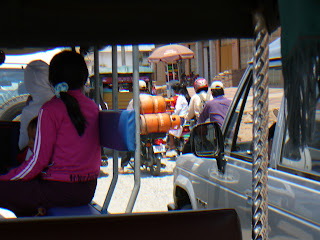So, over Easter I was in Cambodia. Beautiful country.
Now, there is a lot of traffic on the road. A lot. Trucks, cars, tuk-tuks, motor cycles ("motos"), bikes, pedestrians. Cairo and Paris are generally known to have the worst traffic in the world, but Phnom Penh competes valiantly.
The system used for collision avoidance is the same sophisticated and time-honed system applied in aviation under VFR (visual flight rules): See and avoid. So, traffic lights, lines on the road etc. are considered mere recommendations.
The safest way to cross a street is to close your eyes, step on the street and walk at a steady speed on a straight line to wherever you want to go. People will just anticipate that and drive around you. If you commit the beginner's mistake of stopping, looking, or even just hesitating, everyone else will get confused and run into you.
In most places, turning is a 5-step-process:
In California, the first three steps are generally skipped. In Cambodia, the fourth one is skipped, too. You just turn, traffic or no traffic. "See and avoid" takes care of the rest. In the picture below, we're turning left through the oncoming traffic. As you can see, the closest moto has already begun to swerve to his left as to avoid us.
.jpg)
Most people were wearing a baseball hat for crash protection, so did I.
Now, there are many modes of transport. For example, to transport a family of four, you take a moto:

To transport four mattresses, you take a moto:

To transport a monk, you take a moto:

To transport gas and other explosives, you take a moto:

To transport a moto though, you take a bus:
.jpg)
Now, there is a lot of traffic on the road. A lot. Trucks, cars, tuk-tuks, motor cycles ("motos"), bikes, pedestrians. Cairo and Paris are generally known to have the worst traffic in the world, but Phnom Penh competes valiantly.
The system used for collision avoidance is the same sophisticated and time-honed system applied in aviation under VFR (visual flight rules): See and avoid. So, traffic lights, lines on the road etc. are considered mere recommendations.
The safest way to cross a street is to close your eyes, step on the street and walk at a steady speed on a straight line to wherever you want to go. People will just anticipate that and drive around you. If you commit the beginner's mistake of stopping, looking, or even just hesitating, everyone else will get confused and run into you.
In most places, turning is a 5-step-process:
- you look in the mirror,
- you indicate with your turning signals,
- you look over your shoulder,
- you wait for a gap in the traffic,
- you turn.
In California, the first three steps are generally skipped. In Cambodia, the fourth one is skipped, too. You just turn, traffic or no traffic. "See and avoid" takes care of the rest. In the picture below, we're turning left through the oncoming traffic. As you can see, the closest moto has already begun to swerve to his left as to avoid us.
.jpg)
Most people were wearing a baseball hat for crash protection, so did I.
Now, there are many modes of transport. For example, to transport a family of four, you take a moto:

To transport four mattresses, you take a moto:

To transport a monk, you take a moto:

To transport gas and other explosives, you take a moto:

To transport a moto though, you take a bus:
.jpg)
